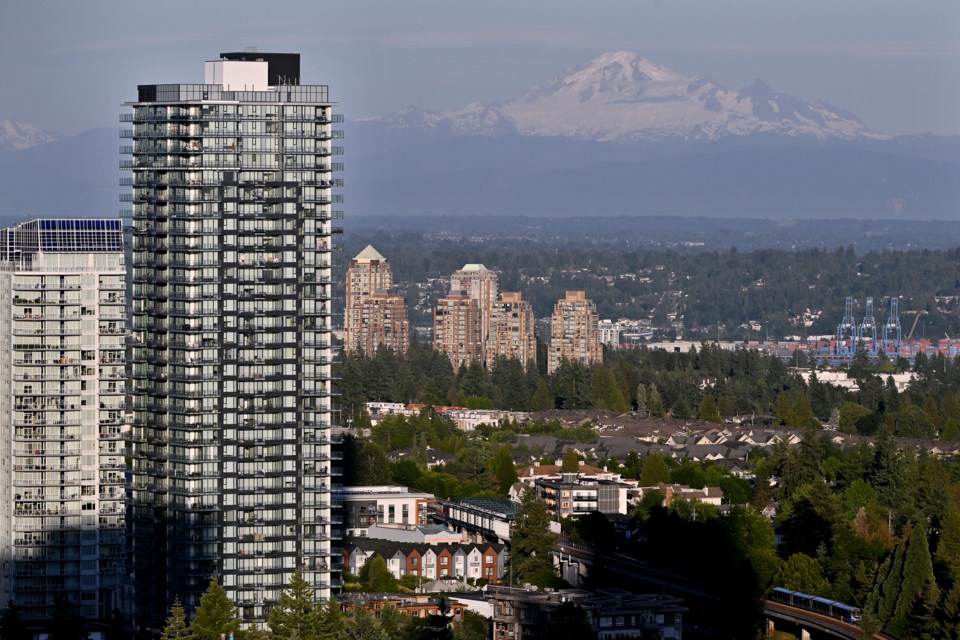Burnaby has made sweeping changes to its oft-touted affordable rental policy to keep developers building in the city.
Once called “sacrosanct,” the policy originally required developers to build 20% of a development as below-market rental units to be rented at rates 20% below the market median for the neighbourhood – a rate locally called “Burnaby affordable.”
At a meeting Oct. 7, city council approved changes to the “rental-use zoning” policy that will slash the “Burnaby affordable” rate and ratio of non-market rental homes built in new developments.
A financial analysis has shown policy amendments are necessary because of the “challenging macro-economic climate for development,” according to a city staff report.
The policy originally ensured developers could recoup the cost of building the 20% non-market units by allowing them to build taller buildings with more homes, which they can sell to offset the cost of the non-market rentals.
But now, according to the financial analysis, that extra density is “generally not sufficient” to cover the costs of inclusionary rental homes due to:
- increasing construction costs,
- rising interest rates,
- inflationary increases in material and labour costs, and
- increases to development charges
These factors mean developers are taking in less revenue.
And new provincial housing legislation now also requires rental policies like Burnaby’s to be codified into a bylaw, according to the report, and requires the bylaw to be financially viable and can’t deter development.
Reducing Burnaby’s rental requirements
Council voted to reduce the policy from 20% required non-market rentals to 15%, and changed the below-market rates: 10% of the units to be rented at 20% below the median and 5% at the median.
(The Canada Mortgage and Housing Corp.’s median rent represents about a 40% discount on market rents, according to the staff report.)
But staff originally recommended, based on the financial analysis, to reduce the percentage even further, from 20% of the development built as non-market rentals to 10%.
Ed Kozak, general manager of planning and development, told council changing the rates beyond what was recommended “would be creating a bylaw that we know does not have financial viability.”
(While the staff report noted “financially viable” is a term “not necessarily well defined by legislation,” the city specified it as a 15% return on investment.)
But councillors disagreed with staff’s recommendations and changed the inclusionary rates.
“You have given us your best advice,” said Coun. Sav Dhaliwal. “Council feels that in order to be an affordable community, we need more than that.”
Couns. James Wang and Richard Lee opposed changing staff’s recommendation, as they argued it was more important for builders to build in Burnaby with fewer inclusionary rentals rather than risking no development and no rentals at all.
Coun. Pietro Calendino said developers just don’t want extra costs for providing affordable housing.
“Whatever we provide to developers, they will never be happy,” he said.
“All they want to do is market housing. So our job here is to ensure we protect citizens who need to have affordable housing,” Coun. Pietro Calendino said, adding the city can try the rate for a year and change it if developers stop building.
Staff say the changes will only result in a “modest reduction compared to the current policy,” noting because of the density offset (the additional market strata homes built to pay for the non-market rentals), the actual percentage of a development’s non-market rentals is between 11 and 15% of total units.
More RUZP changes
The report approved by council outlined eight amendments to the rental-use zoning policy, including the following.
- Southeast Burnaby, with the exception of the Southgate development, will be excluded from the non-market rental requirement.
- Developers will only be required to build non-market rentals on strata developments, not market rental or co-ops.
- Non-market rentals will only be required for developments in certain areas zoned for more than six storeys.
- In the “R5” zone of up to 12 storeys, only 10% of the development will be rented at CMHC median rents.
- Developers will be permitted to transfer non-market rentals within the same CMHC zone.
- Staff will consider the idea of allowing developers to pay cash instead of building the non-market rentals.
The developments will fall under the new or old policy requirement depending on when they applied to the city.
For development proposals that are already in the application process, developers can choose to submit under the updated policy but will be required to abandon their current application and submit a new one.
In the four years since its adoption, Burnaby’s rental-use zoning policy has created a total of 6,491 non-market rental homes, when counting all homes proposed, approved, under construction and completed.
Specific bylaws to implement the changes will be presented for council approval at a later date.
Read the original rental-use zoning policy, adopted in 2020.
Read the 2024 amendments here (start at page 13).





